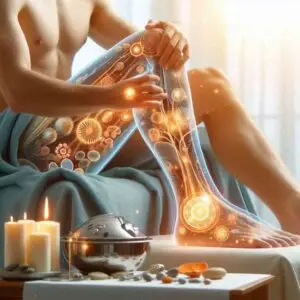Lymphedema is often thought of as a condition that solely causes swelling, but for those living with it, the reality is more complex. The heavy, swollen limbs can bring a nagging, persistent pain that lingers like an unwelcome guest. This pain isn’t just a side effect—it can spiral into a chronic condition, reshaping daily life. How does lymphedema contribute to chronic pain, and what can be done to manage it? This article explores the connection, delving into the science, the struggles, and the strategies for finding relief.
What Is Lymphedema?
Lymphedema occurs when the lymphatic system, the body’s drainage network, gets blocked or damaged. Fluid builds up, causing swelling in areas like the arms, legs, or torso. It’s commonly linked to cancer treatments, such as lymph node removal or radiation, but can also stem from injuries, infections, or genetic disorders. The swelling isn’t just a visual change—it can also feel tight, heavy, or uncomfortable, affecting your movement and overall well-being.
For many, lymphedema is more than puffiness. It’s a chronic condition that requires daily management, and pain is often part of the package. Whether it’s a dull ache or a sharp sting, this discomfort can wear you down, making it crucial to understand how lymphedema intertwines with chronic pain and what that means for those affected.
Understanding Chronic Pain
Chronic pain is pain that persists for months or even years, often outlasting its initial cause. It’s not just a physical sensation—it can mess with your mood, sleep, and overall quality of life. Unlike acute pain, which signals a specific injury, chronic pain can persist even when the initial problem appears to be resolved. For lymphedema patients, chronic pain often begins with swelling but can evolve into a more complex condition driven by tissue changes or nerve irritation.
Think of chronic pain as a faulty alarm system. Your body keeps sounding the alert long after the danger has passed. In lymphedema, this alarm can be triggered by fluid pressure, inflammation, or even the emotional stress of living with a visible condition. Understanding this helps explain why lymphedema pain isn’t just about the swelling—it’s about how the body and mind respond over time.
How Lymphedema Contributes to Chronic Pain
Lymphedema doesn’t just cause swelling—it sets off a chain reaction that can lead to ongoing pain. The fluid buildup puts pressure on tissues, nerves, and joints, creating discomfort that ranges from mild to debilitating. Over time, this pressure can change the skin and underlying tissues, making them firmer and less flexible, which adds to the pain. But how exactly does this happen, and why does it become chronic?
The swelling stretches the skin, causing it to feel tight or burn. Nerves caught in the mix get irritated, sending pain signals that don’t always fade. For some, the heaviness of a swollen limb makes movement painful, leading to muscle strain or joint stress. One woman I heard about described her swollen arm as “a constant throb” that flared up with every lift or reach. These physical changes, left unchecked, can turn episodic pain into a daily reality.
Tissue Fibrosis and Pain
As lymphedema progresses, especially in later stages, the tissue can become fibrotic—rigid and less pliable. This fibrosis adds a layer of stiffness that makes movement painful. It’s like trying to bend a piece of leather that’s gone rigid. The hardened tissue presses on nerves and blood vessels, amplifying discomfort. This is why early treatment is so critical—keeping the tissue soft can prevent pain from becoming a permanent fixture.
Nerve Irritation and Neuropathic Pain
Lymphedema can irritate nerves, leading to neuropathic pain—a burning, tingling, or shooting sensation. This happens when swollen tissues compress nerves or when inflammation disrupts their function. For example, a patient with leg lymphedema might feel sharp zaps down their calf, even at rest. Neuropathic pain is tricky because it doesn’t always respond to standard painkillers, making specialized care essential.
The Emotional Toll of Chronic Pain
Pain isn’t just physical—it’s emotional. Living with lymphedema’s chronic pain can spark frustration, anxiety, or even depression. Imagine waking up every day knowing your leg will ache before you even get out of bed. That constant anticipation wears you down. For many, the pain becomes a reminder of the trauma that caused the lymphedema, like cancer or a severe injury, adding an emotional layer to the physical struggle.
This emotional toll can amplify pain perception. Stress or low mood can make the brain more sensitive to pain signals, creating a vicious cycle. One man shared how his arm pain felt worse on days he was stressed about work, even if the swelling hadn’t changed. Addressing the emotional side isn’t just a bonus—it’s a key part of managing chronic pain in lymphedema.
Risk Factors for Chronic Pain in Lymphedema
Not everyone with lymphedema develops chronic pain, but certain factors up the odds. The severity of the swelling is a big one—Stage 3 lymphedema, with its fibrotic tissue, is more likely to cause pain than Stage 1. The location matters, too; a swollen arm used for daily tasks might hurt more than a less active area. Delaying treatment is another risk—untreated swelling progresses, leading to increased discomfort.
Other health conditions, such as arthritis or diabetes, can exacerbate pain by increasing joint stress or nerve damage. Lifestyle factors, such as prolonged sitting or a poor diet, can aggravate swelling and inflammation, thereby fueling the pain cycle. One patient noticed her leg pain spiked after long flights, a sign that immobility was a trigger. Knowing these risks helps target prevention and treatment.
Infections and Pain Flare-Ups
Infections, such as cellulitis, are a significant source of pain in lymphedema. Swollen tissue is a breeding ground for bacteria, and an infection can cause intense pain, redness, and more swelling. These flare-ups can disrupt mobility and make existing pain feel unbearable. One woman described a cellulitis episode as “like my leg was on fire,” sidelining her for weeks. Preventing infections through vigilant skin care is essential for adequate pain control.
Diagnosing Pain in Lymphedema Patients
Figuring out why lymphedema causes chronic pain takes detective work. Doctors start with a thorough history—when did the pain begin, what triggers it, and how does it feel? They’ll check the swelling’s stage and look for signs of fibrosis or infection. Tests like lymphoscintigraphy can map lymphatic flow, while nerve studies might pinpoint neuropathic pain.
The challenge is distinguishing lymphedema pain from other causes, like arthritis or muscle strain. A good provider listens closely to the patient’s description—burning pain might suggest nerve issues while aching could point to tissue pressure. One guy I read about was misdiagnosed with arthritis for years until a lymphedema specialist connected his leg pain to swelling. Getting the correct diagnosis is the first step to relief.
The Role of Pain Scales
Pain is personal, so doctors often use pain scales to gauge its intensity. Patients may rate their pain on a scale of 1 to 10 or describe how it affects their daily tasks, such as walking or sleeping. This helps tailor treatment—mild pain may require lifestyle adjustments, while severe pain may necessitate medication or therapy. Being honest about your pain, even if it feels “not that bad,” ensures you get the proper care.
Managing Chronic Pain in Lymphedema
Managing lymphedema-related pain involves addressing both the swelling and the discomfort it causes. It’s not a one-size-fits-all solution—it requires a combination of therapies, lifestyle changes, and sometimes a bit of trial and error. The goal? Reduce pain enough to live your life, not just endure it.
Complete Decongestive Therapy (CDT)
CDT is the go-to for lymphedema, combining manual lymph drainage, compression, exercise, and skincare. Manual lymphatic drainage, a gentle massage, helps move fluid out of swollen areas, easing pressure on tissues and nerves. Compression garments or bandages help reduce swelling, thereby decreasing the strain that contributes to pain. One patient said her compression sleeve cut her arm pain in half, letting her cook dinner without wincing.
Exercise in CDT, such as gentle stretches or walking, boosts lymph flow and loosens stiff joints, which can help alleviate discomfort. Skincare prevents infections that spike pain. A trained lymphedema therapist customizes CDT to meet your specific needs, ensuring it effectively targets both swelling and pain.
Pain Medications and Therapies
For some, medications help manage chronic pain. Over-the-counter options like ibuprofen can ease inflammation-related discomfort, while neuropathic pain might need drugs like gabapentin. These aren’t long-term fixes—they work best in conjunction with other treatments. Non-drug therapies, like transcutaneous electrical nerve stimulation (TENS), can also help by disrupting pain signals. One woman found TENS made her leg pain “quiet enough to sleep,” a small but meaningful win.
Aquatic Therapy
Aquatic therapy is a standout for pain relief. In a warm pool, water’s buoyancy lightens swollen limbs while its pressure acts like natural compression. This reduces tissue strain and soothes aching nerves. Exercises like arm swings or pool walking improve circulation without jarring the body. A man with leg lymphedema said aquatic therapy was the only time his pain faded completely, giving him hope to keep moving. It’s a gentle way to manage both swelling and discomfort.
Lifestyle Changes to Ease Pain
Your daily habits can significantly impact the pain associated with lymphedema. Movement is key, prolonged sitting or standing pools fluid, worsening pressure and discomfort. Regular, low-impact activities, such as yoga or swimming, help keep lymph flowing and joints loose. Weight management helps, too; extra pounds add strain to swollen limbs. Cutting back on salt reduces fluid retention, thereby easing tissue tension.
Sleep matters more than you’d think. Poor rest can heighten pain perception, so establishing a consistent bedtime routine and maintaining a comfortable sleep position (such as elevating a swollen limb) can be beneficial. One patient found that elevating her arm at night significantly reduced her morning pain. These changes may not be glamorous, but they’re powerful when done consistently.
Stress Management and Mental Health
Stress and pain feed off each other. Anxiety or depression can amplify how much pain you feel, while chronic pain can tank your mood. Techniques such as deep breathing, meditation, or journaling can help calm the nervous system, making pain more manageable. Counseling or support groups offer a space to process the emotional weight of lymphedema. One guy said his support group helped him feel “less alone,” which made his pain seem less overwhelming.
Working with Your Healthcare Team
A strong healthcare team is your lifeline. Lymphedema specialists, pain management doctors, and physical therapists can collaborate to develop a comprehensive plan that addresses both swelling and pain. Regular check-ins catch issues early, like an infection or a garment that’s too tight. If your team isn’t addressing your pain, speak up—bring notes to appointments to stay focused and on track. One patient switched doctors after feeling dismissed and finally got a plan that worked.
Exploring Multidisciplinary Care
Chronic pain often needs a team approach. A lymphedema therapist may manage swelling, while a pain specialist might prescribe medication or therapies such as TENS. A counselor can address emotional triggers, and a nutritionist can tweak your diet. This coordination ensures no aspect of your pain is ignored. It’s like assembling a puzzle—each piece makes the picture clearer.
The Future of Pain Management in Lymphedema
Research is shedding light on the pain associated with lymphedema. New therapies, such as lymphatic surgeries or advanced compression devices, may help reduce swelling and discomfort. Studies on neuropathic pain are exploring drugs and non-invasive treatments that might help. For now, combining proven strategies with a proactive mindset offers the best relief. The field is moving forward, and that’s a sign of hope for less pain down the road.
Conclusion
Lymphedema’s role in chronic pain is undeniable, but it’s not the whole story. By understanding how swelling fuels discomfort and utilizing tools such as CDT, aquatic therapy, and stress management, you can take control of your condition. It’s not about erasing pain—it’s about living better despite it. With proper care and the right mindset, you can alleviate the pain and continue moving forward. Got questions? Here are some answers to help you navigate.
FAQs
Q1: Why does lymphedema cause chronic pain?
Swelling puts pressure on tissues and nerves, while fibrosis and inflammation can cause persistent pain, especially if left untreated.
Q2: Can treating lymphedema reduce chronic pain?
Yes, therapies like Complete Decongestive Therapy reduce swelling, easing tissue pressure and nerve irritation that causes pain.
Q3: Are there medications for lymphedema-related pain?
Over-the-counter anti-inflammatories or neuropathic drugs like gabapentin can help, but they work best with other treatments.
Q4: How does stress affect lymphedema pain?
Stress heightens pain perception by sensitizing the nervous system. Relaxation techniques or counseling can help break this cycle.
Q5: Can aquatic therapy help with lymphedema pain?
Absolutely. Water’s buoyancy and compression reduce swelling and soothe nerves, making movement less painful.





